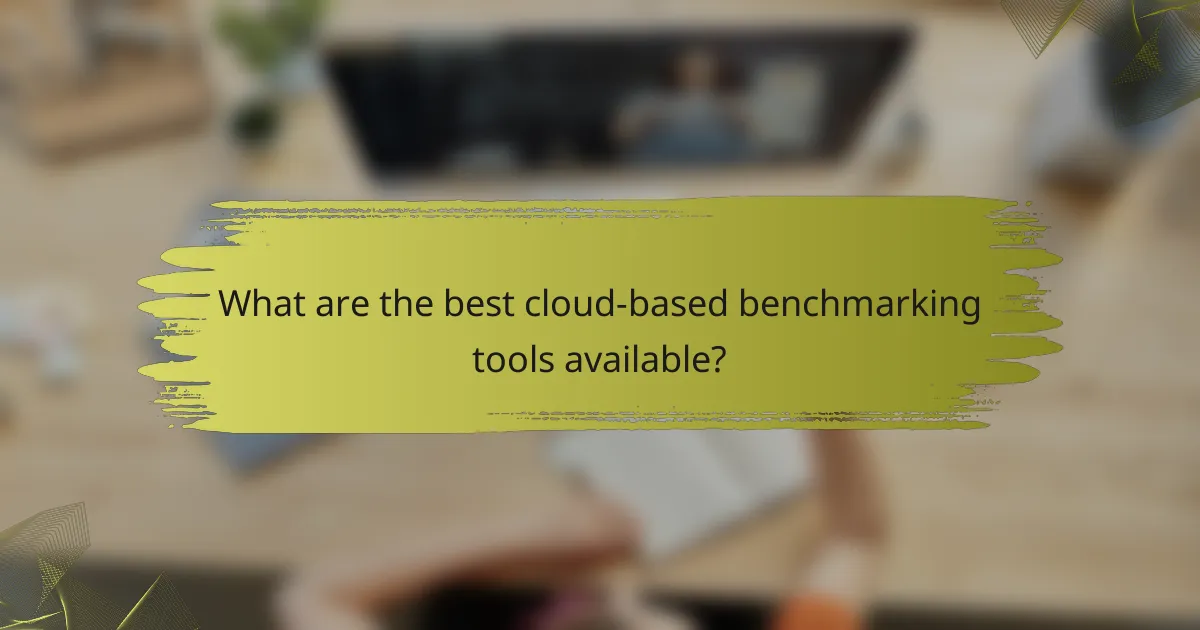Cloud-based benchmarking solutions provide organizations with enhanced scalability, cost savings, and real-time access to data, facilitating improved performance metrics and decision-making. However, challenges such as data privacy concerns, system integration issues, and reliance on internet connectivity must be addressed to ensure effective implementation and operational efficiency.

What are the advantages of cloud-based benchmarking solutions?
Cloud-based benchmarking solutions offer significant benefits, including enhanced scalability, cost savings, and real-time data access. These advantages enable organizations to optimize their performance metrics and improve decision-making processes efficiently.
Scalability and flexibility
Cloud-based benchmarking solutions provide remarkable scalability, allowing organizations to adjust their resources based on demand. This flexibility means businesses can easily scale up during peak times or downsize during slower periods without incurring heavy costs.
For example, a company may need to analyze data from multiple departments simultaneously during a product launch. Cloud solutions can accommodate this increased demand without requiring extensive hardware investments.
Cost-effectiveness
Utilizing cloud-based benchmarking can lead to significant cost savings compared to traditional on-premises solutions. Organizations can avoid hefty upfront costs associated with hardware and software purchases, opting instead for a subscription-based model that aligns with their budget.
Many cloud providers offer tiered pricing plans, allowing businesses to select a package that meets their specific needs. This pay-as-you-go approach can be particularly beneficial for small to medium-sized enterprises looking to manage expenses effectively.
Real-time data access
One of the key advantages of cloud-based benchmarking is real-time data access, which allows organizations to monitor performance metrics instantly. This immediacy enables quicker decision-making and the ability to respond promptly to emerging trends or issues.
For instance, a marketing team can track campaign performance in real-time, adjusting strategies based on immediate feedback rather than waiting for periodic reports. This agility can lead to improved outcomes and higher ROI.
Enhanced collaboration
Cloud-based solutions facilitate enhanced collaboration among teams, regardless of their physical locations. Multiple users can access and analyze the same data simultaneously, fostering a more integrated approach to benchmarking.
This collaborative environment is particularly useful for global teams working on joint projects, as it eliminates barriers and ensures everyone is on the same page. Tools like shared dashboards and collaborative reports can further streamline this process.
Improved data security
Security is a critical concern for organizations, and cloud-based benchmarking solutions often come with advanced security features. Providers typically invest in robust security measures, including encryption and regular updates, to protect sensitive data.
Additionally, many cloud services comply with industry standards and regulations, such as GDPR or HIPAA, ensuring that organizations meet necessary legal requirements. This level of security can be more challenging to achieve with on-premises solutions.

What challenges do organizations face with cloud-based benchmarking?
Organizations encounter several challenges with cloud-based benchmarking, including data privacy concerns, system integration issues, reliance on internet connectivity, and potential vendor lock-in. Addressing these challenges is crucial for effective benchmarking and maintaining operational efficiency.
Data privacy concerns
Data privacy is a significant challenge for organizations using cloud-based benchmarking solutions. Sensitive information may be exposed to unauthorized access or breaches, especially if the cloud provider does not comply with regulations like GDPR or CCPA. Organizations must ensure that their cloud vendors implement robust security measures to protect data integrity.
To mitigate risks, companies should conduct thorough assessments of their cloud providers’ security protocols and data handling practices. Regular audits and compliance checks can help maintain data privacy and build trust with stakeholders.
Integration with existing systems
Integrating cloud-based benchmarking solutions with existing systems can be complex and time-consuming. Organizations often face compatibility issues with legacy systems, which may hinder data flow and analysis. A well-planned integration strategy is essential to ensure seamless operations.
To facilitate integration, businesses should prioritize solutions that offer APIs or connectors compatible with their current infrastructure. Engaging IT professionals during the integration process can help identify potential roadblocks and streamline the transition.
Dependence on internet connectivity
Cloud-based benchmarking relies heavily on stable internet connectivity, which can be a challenge in areas with poor network infrastructure. Downtime or slow connections can disrupt access to critical benchmarking data, impacting decision-making processes. Organizations must account for these dependencies when planning their cloud strategies.
To address connectivity issues, companies can consider implementing backup internet solutions or hybrid models that combine cloud and on-premises resources. This approach can enhance reliability and ensure continuous access to benchmarking tools.
Vendor lock-in issues
Vendor lock-in occurs when organizations become overly dependent on a specific cloud provider, making it difficult to switch vendors or migrate data. This situation can limit flexibility and increase costs if the vendor raises prices or fails to meet evolving needs. Understanding the implications of vendor lock-in is crucial for long-term planning.
To avoid lock-in, organizations should choose cloud solutions that support open standards and interoperability. Regularly reviewing contracts and assessing alternative providers can help maintain leverage and ensure that businesses remain adaptable in a changing market.

How do cloud-based benchmarking solutions transform business operations?
Cloud-based benchmarking solutions significantly enhance business operations by providing real-time data analysis and insights. These tools enable organizations to compare their performance against industry standards, leading to informed decision-making and optimized processes.
Streamlined decision-making processes
Cloud-based benchmarking solutions facilitate quicker decision-making by offering instant access to relevant data. Businesses can analyze performance metrics in real-time, allowing for timely adjustments and strategic pivots. For instance, a retail company can quickly assess sales data against competitors to identify trends and adapt marketing strategies accordingly.
To maximize the benefits, organizations should ensure that their data is accurate and up-to-date. Regularly reviewing benchmarking criteria and adjusting them based on evolving industry standards is crucial for maintaining relevance.
Increased operational efficiency
By utilizing cloud-based benchmarking, companies can identify inefficiencies in their operations and implement corrective measures. These solutions allow for continuous monitoring of key performance indicators (KPIs), enabling teams to spot areas needing improvement. For example, a manufacturing firm might discover that production delays are affecting overall output and can take steps to streamline processes.
To enhance operational efficiency, businesses should prioritize integrating benchmarking tools with existing systems. This integration can help automate data collection and reporting, reducing manual effort and errors.
Enhanced competitive analysis
Cloud-based benchmarking solutions provide valuable insights into competitors’ performance, helping businesses understand their market position. By analyzing industry benchmarks, companies can identify their strengths and weaknesses relative to peers. This information is vital for developing strategies that capitalize on competitive advantages.
Organizations should regularly conduct competitive analyses using these tools to stay ahead. Setting specific benchmarking goals, such as improving customer satisfaction scores or reducing operational costs by a certain percentage, can guide strategic initiatives effectively.

What criteria should businesses consider when selecting a cloud-based benchmarking solution?
Businesses should consider scalability, integration capabilities, and cost structure when selecting a cloud-based benchmarking solution. These factors directly impact the effectiveness and efficiency of the benchmarking process, ensuring that the solution aligns with business needs and growth objectives.
Scalability requirements
Scalability is crucial as it determines how well a benchmarking solution can grow with your business. Look for solutions that can handle increased data loads and user demands without compromising performance. A good benchmark is to choose a solution that can scale up to accommodate at least double your current requirements.
Consider whether the solution allows for easy upgrades or additional features as your needs evolve. For instance, a solution that supports modular add-ons can be more beneficial than a rigid system that requires a complete overhaul to scale.
Integration capabilities
Integration capabilities refer to how well the benchmarking solution can connect with your existing systems and data sources. A solution that seamlessly integrates with your CRM, ERP, or other tools can significantly enhance data accuracy and reduce manual entry errors. Look for solutions that offer APIs or pre-built connectors for popular platforms.
Evaluate the ease of integration by checking user reviews or case studies. Solutions that require extensive customization may lead to higher costs and longer implementation times, which can be a drawback for many businesses.
Cost structure analysis
Understanding the cost structure of a cloud-based benchmarking solution is essential for budgeting and financial planning. Costs can vary widely based on features, user licenses, and data storage needs. Assess whether the pricing model is subscription-based, pay-per-use, or a one-time fee, and consider which aligns best with your financial strategy.
Additionally, factor in potential hidden costs, such as fees for additional users or data exports. A clear breakdown of costs can help avoid surprises and ensure that the solution provides good value for the investment.

What are the best cloud-based benchmarking tools available?
The best cloud-based benchmarking tools offer a range of features that facilitate data analysis and performance evaluation. These tools help organizations compare their metrics against industry standards, enabling informed decision-making and strategic planning.
Tableau
Tableau is a powerful cloud-based benchmarking tool known for its data visualization capabilities. It allows users to create interactive dashboards that can display key performance indicators (KPIs) and other metrics in real-time, making it easier to analyze performance trends.
When using Tableau for benchmarking, consider its integration with various data sources, including cloud databases and spreadsheets. This flexibility allows organizations to pull in data from multiple platforms, enhancing the comprehensiveness of their analyses.
To maximize Tableau’s effectiveness, focus on creating clear visualizations that highlight critical benchmarks. Avoid cluttering dashboards with excessive information; instead, prioritize the most relevant data points to facilitate quick insights and decision-making.



